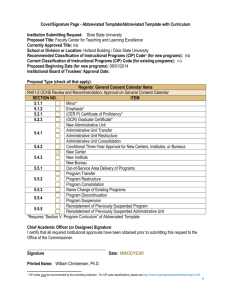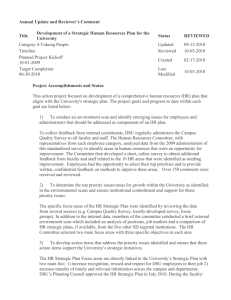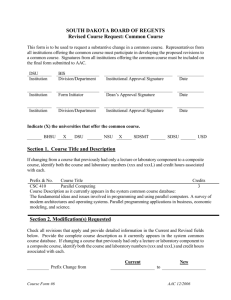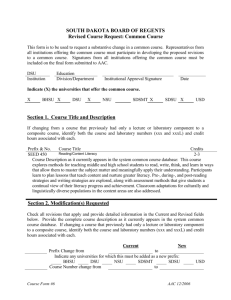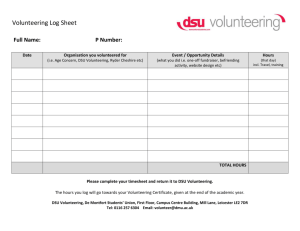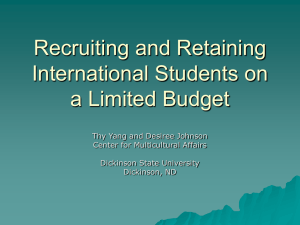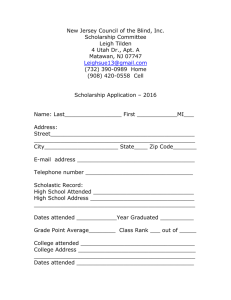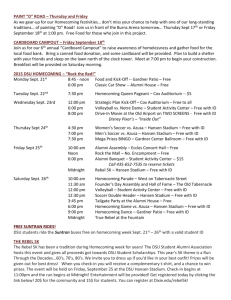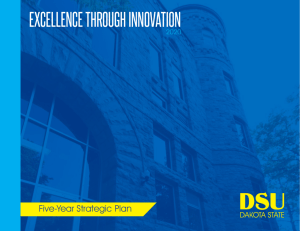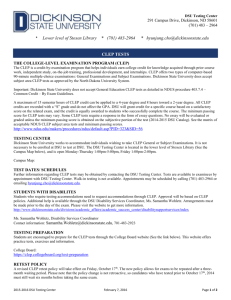Faculty Center for Teaching Excellence
advertisement
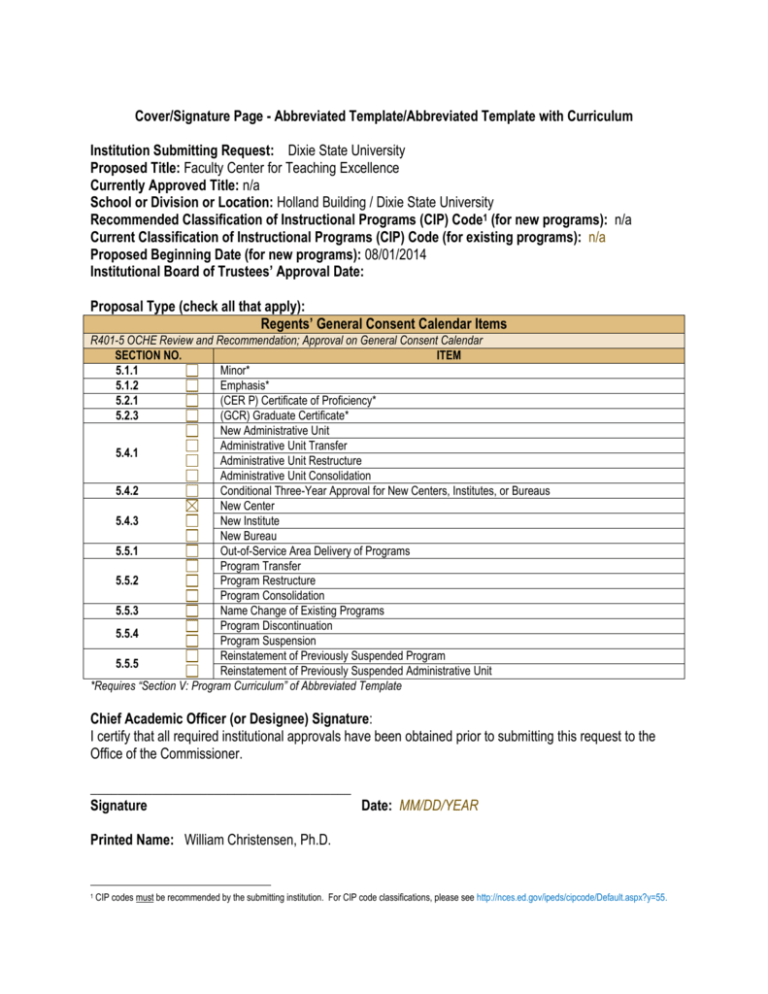
Cover/Signature Page - Abbreviated Template/Abbreviated Template with Curriculum Institution Submitting Request: Dixie State University Proposed Title: Faculty Center for Teaching Excellence Currently Approved Title: n/a School or Division or Location: Holland Building / Dixie State University Recommended Classification of Instructional Programs (CIP) Code1 (for new programs): n/a Current Classification of Instructional Programs (CIP) Code (for existing programs): n/a Proposed Beginning Date (for new programs): 08/01/2014 Institutional Board of Trustees’ Approval Date: Proposal Type (check all that apply): Regents’ General Consent Calendar Items R401-5 OCHE Review and Recommendation; Approval on General Consent Calendar SECTION NO. ITEM 5.1.1 Minor* 5.1.2 Emphasis* 5.2.1 (CER P) Certificate of Proficiency* 5.2.3 (GCR) Graduate Certificate* New Administrative Unit Administrative Unit Transfer 5.4.1 Administrative Unit Restructure Administrative Unit Consolidation 5.4.2 Conditional Three-Year Approval for New Centers, Institutes, or Bureaus New Center 5.4.3 New Institute New Bureau 5.5.1 Out-of-Service Area Delivery of Programs Program Transfer 5.5.2 Program Restructure Program Consolidation 5.5.3 Name Change of Existing Programs Program Discontinuation 5.5.4 Program Suspension Reinstatement of Previously Suspended Program 5.5.5 Reinstatement of Previously Suspended Administrative Unit *Requires “Section V: Program Curriculum” of Abbreviated Template Chief Academic Officer (or Designee) Signature: I certify that all required institutional approvals have been obtained prior to submitting this request to the Office of the Commissioner. ______________________________________ Signature Date: MM/DD/YEAR Printed Name: William Christensen, Ph.D. 1 CIP codes must be recommended by the submitting institution. For CIP code classifications, please see http://nces.ed.gov/ipeds/cipcode/Default.aspx?y=55. Program Request - Abbreviated Template Dixie State University Faculty Development Center 08/01/2014 Section I: Request As a teaching university, DSU is in a unique position to focus energy and resources on the art and science of teaching. To that end, the Dixie State University Committee for Teaching and Learning recommends and requests the establishment of a Faculty Center for Teaching Excellence to support the development of educators at DSU, to enhance our unique culture as a teaching university, and to enrich DSU’s faculty to continue to develop their pedagogical expertise for the benefit of all our students. The Committee identified faculty development activities currently in place and investigated national best practices, including faculty learning centers. The synergy between technology and experiential teaching and DSU’s unique commitment to a culture of learning, community, and values, and a belief in a learner-centered approach, focused our discussions and led to our recommendation for the development of a Center for Faculty Excellence. The mission of the Center will be to foster teaching excellence by providing resources, opportunities for enrichment, and strategies to encourage and support quality and innovative teaching. The Center would have both a physical and an on-line presence allowing faculty to share effective practices and enhance their teaching skills in the time and space that most appeals to them. Additionally, the Center will serve as a clearinghouse to help integrate the various professional development opportunities offered to faculty at DSU. We strongly advocate that the Center be championed by the faculty and that the Center’s activities advocate for all educators, including adjuncts. Participation is voluntary for all educators, at all stages of their careers. The Center will help the continued development of quality instruction and foster innovative approaches to the scholarship of teaching and learning, innovation and excellence. The following report provides a path for the creation of the Center, including an organizational structure and a supportive budget. The Committee proposes immediate goals for the Center, including appointing a full time director selected from the DSU faculty, and maintaining a planning/advisory council (currently the Teaching and Learning Committee), a centrally located facility, a speaker series, a yearly invitational conference, and both an online and face-to-face presence. Section II: Need Most of our state’s public higher education institutions have dedicated faculty development centers that create a concerted effort toward improvement in teaching and learning on their campuses. Based on a list of public higher education institutions in Utah (http://www.utah.gov/education/colleges.html), we found the following institutions have dedicated centers: · Salt Lake Community College, · Southern Utah University · University of Utah · Utah State University · Utah Valley University · Weber State University Other Dixie State University sister institutions, such as Humboldt State University and Clayton State University, also house faculty development centers. Faculty development centers in Utah’s public higher education institutions vary in size and offerings. Personnel structure within these institutions ranges from two staff (Weber State University) to thirteen staff (Utah State University). There is also a range in leadership structure from jointly-appointed faculty directors (Utah Valley University, University of Utah, and Weber State University) to dedicated full-time directors (Utah State University). Personnel titles include directors, associate directors, coordinators, consultants, administrative assistants, and office assistants, amongst others. These centers seek to enrich the campus community by offering services such as new faculty orientations and workshops, adjunct faculty workshops, teaching academies, mentorships, personal learning networks and communities, book clubs, and forums, mirroring the goals of DSU Center. Faculty development centers can have significant impact on the institutional structure and culture that values and rewards teaching (Chism, 1998; Polich, 2008; Sorceinelli & Aitken, 1995). Descriptive studies have asserted their effectiveness in enhancing teaching and learning, positive attitudes toward teaching, increased knowledge of educational principles, and improvements in teaching skills and teaching behaviors (Cox, 2004; Henderson & Buchanan, 2007; Umbach and Wawrznski , 2005). These studies showed that the faculty participation had a significant impact on the number of participants who received tenure, had lower rate of stress, and had a better worklife balance. In a recent study conducted in a public research university, 87% of the participants in a faculty learning community reported a change in their epistemological beliefs and 79% reported a change in their teaching methods (Miller, 2008; Polich, 2008). Faculty development programs have been established at a majority of four year institutions (Sorceinelli & Aitken, 1995), addressing widespread needs to support faculty in their growth as teachers, scholars, and professionals. Strategies to improve teaching and learning are often a focus. Development programs are diverse in nature to meet the needs of targeted populations during the different phases of a faculty member’s career. The selection of development activities can assist with campus initiatives or common instructional challenges. These activities should have appeal across the disciplines, be provided in both face-to-face and web based environments, and build upon local strengths to enhance instructional excellence (Umbach & Wawrzynski, 2005). Section III: Institutional Impact 1. Director. It is essential that the Center for Excellence in Teaching and Learning develop and grow under the leadership of a faculty Director. The Director’s primary responsibilities are to plan, manage, and conduct Center activities. The Director should be an established teacher-scholar from DSU whose sole responsibility is to conduct Center affairs and who reports directly to the Dean of Academic Outreach. 2. Teaching and Learning Committee. A volunteer committee of faculty will provide advice and support to the Director. This Council should meet throughout the year to discuss strategic direction, review plans, propose initiatives, and conduct formative reviews for the Center. The membership of that committee will be on a 2 year staggered rotational basis. 3. Support Staff and Equipment. The Center will collaborate with the existing entities (library, technology, Faculty Development, etc.) to minimize the need for an extensive support staff or new equipment. 4. Fellowship Appointments. A select group (2 or 3 faculty per year) should receive one year appointments as Teaching and Learning Center Fellows. Fellows contribute to the mission of the Center by engaging in supportive endeavors with DSU faculty in activities such as campus presentations, mentoring faculty, and/or shared research. Each Center Fellow will also assist the Director to lead a scholarly initiative on campus. The Director and the Teaching and Learning Committee will develop a competitive application process for Center Fellows, and should award fellowships accordingly. Selection should take into consideration faculty expertise. Such expertise may include contributions in key areas, or the ability to enhance the community through the development of materials and resources in focal areas. . Facilities 1. Central Location. We recommend that the Center be provided office space that suggests the centrality of teaching and learning at DSU. A location in the Holland Common Center provides both a central location and a direct connection with the academic mission of The College and a connection to the already established Faculty Development area. 2. Office Space. The Center should provide office space for the Director and the support staff. 3. Conference Room. The Center will share a conference room with Faculty Development where it can schedule meetings, conduct small projects, and prepare activities. 4. Presentation Space. The Center’s presentations, programs, and public activities require a consistent, identifiable location in the HCC that gives it presence as a vital campus entity. The current Faculty Development area would be ideal. 5. Office Workroom. The Center should have office space for material preparation, copying, storage of Center materials, and work area for creating Center programs and activities. It is anticipated that workspace may be shared with Faculty Development, at least in the initial phase of Center development. Equipment and Supplies 1. Copier. The Center should have direct access to a copier so that Center staff can prepare materials for public distribution and information for campus educators, as well as conducting its own activities and managing its affairs. 2. Information Technology. The Center should have computing and presentation equipment to support its activities. The Director and Fellows need compatible computers. The Center should have direct access to demonstration equipment and presentation technology. Hence, the initial recommendation includes supplying PC laptops and a portable projector for the Center Director, Fellows, and staff to use during the activities for the Center. 3. Supplies. The Center needs to be provided with supplies to support its programs and projects. Section IV: Finances Budget We suggest the following Budget to support our proposal. 1. Operating Expenses Item Cost Director Full time Total 60,000 Support Staff Webmaster, secretarial, etc. We anticipate using work study students as much as possible and coordinating with existing Faculty Learning personnel to minimize cost. $5,000 x Subtotal 2. Facilities Item Office space $ 65,000 Cost Total Can share existing space in the Holland Commons Center with the Faculty Development , 3rd floor, since their mission is a subset of the Center mission Conference room Presentation room Work area Model classroom Subtotal 0 3. Equipment & Supplies Item Cost Computers 2 x $800 (two laptops,) Total $1,600 Portable Projector $1500 $1,500 General supplies Subtotal $5,000 $5,000 4. Center Initiatives Item Cost Annual To promote scholarship and share best practices among state teaching Conference university faculties $8,100 Total $6,000 Faculty Learning Communities Webpage/ newsletter Support materials (books, travel, etc.) $10,000 Center Fellows 3 x $1,000 during fall and spring semesters $ 6,000 Open Classroom Teaching Scholars Faculty Developers $50 per half day x 20 days (to conduct innovative teaching demonstrations and discussions) $2,000 Support faculty to assist new professors, adjuncts, and others seeking support in various aspects of course development, evaluation, etc. $4,000 Grants Competitive grants for the development and promotion of innovative pedagogy $5,000. $2,000 Subtotal $35,000. Area Operating Expenses Sub-total $65,000 Office Space 0 Equipment & Supplies $8,100 Center Initiatives $35,000 Total $108,100 Section V: Program Curriculum Guiding Principles The Center is to be a resource for educational support, as well as enrichment and development experiences. Planning and implementation of activities of the Center are guided by the following principles: 1. Focusing on enhancing learning through more effective teaching, mentoring, and advising. 2. Facilitating communication among educators to share pedagogical expertise across disciplines and celebrate campus achievements in teaching and learning. 3. Providing a central location for the coordination and dissemination of information about all educator development activities. 4. Maintaining the culture of faculty ownership, advocating for educators in their role as teachers, and insuring that participation in programs, consultations, and assessments is voluntary, confidential, and developmental. 5. Supporting the ongoing development of the teacher-scholar model and facilitating innovative approaches to the scholarship of teaching and learning. 6. Facilitating community explorations of national best practices in teaching and learning, and promoting DSU accomplishments in state, regional, and national venues. Programs As we begin the implementation of a Center at DSU we recommend the development and publicity of campus offerings be completed by the first week of the academic year. Common online and face-to-face workshops will include: new faculty workshops, active learning and pedagogy, discussion series, instructional technology, and faculty learning community topics. It is important to connect the various faculty development opportunities to student learning and outcomes, and the impact of the faculty development activities should be measured by the Teaching and Learning Committee. The Center should support a wide array of programs and projects; each designed to support different needs. During its first year, the Center Director and Teaching and Learning Committee can consider an appropriate mix and level of support for various efforts. We recommend the following initiatives during this first year, commencing in August of 2014: Conference. Planning for an annual invitational conference to support teaching excellence and scholarship. Speaker Series. The Center should sponsor an annual speaker series. We suggest that a visible national speaker be arranged. In addition, we recommend that faculty from the university and other local experts be recruited into a sponsored series. The Center Director and the Teaching and Learning Committee should consider inviting visiting scholars to contribute to initiatives of the Center. This might involve an extended (one or two week) visit and could be co-sponsored by Academic Affairs. Open Classrooms. The Center should sponsor a series of Open Classrooms provided by faculty who are willing to allow others to visit their class as they demonstrate a pedagogical approach or innovation. These visits will be followed by a discussion session. Web Site. A website to explore and promote best practices should be developed as an informational tool as well as a clearinghouse for all faculty development opportunities. Faculty Learning Communities. Many institutions have employed faculty learning communities from different fields who are motivated by a shared set of concerns or interests in a topic. They meet regularly to discuss this subject and study the related scholarship on teaching and learning. We recommend the development of two Faculty Learning Communities. The small groups led by the Director and/or Center Fellow(s), will propose a pedagogical theme which they will investigate. The results of the FLC efforts will be shared with the campus community. Learning Communities may be initiated by the Director in consultation with the Teaching and Learning Committee. Faculty may discuss an idea for an FLC with the Director. The FLCs may receive support for travel to a conference on their focused theme and materials, such as books for the group members, as well as a small pool of funds for supplies. Faculty Developers. We recommend the institution of a cadre of faculty developers as needed to meet with faculty, offering formative assessment as well as consultation about planning courses, creating syllabi, assessing student learning, and developing teaching methods. Confidentiality is maintained, and individual consultations are initiated by interested faculty members. Grants. Small, competitive grants for pedagogical research or implementation of pedagogical innovations should be provided by the Center in order to promote a culture of scholarship around teaching and learning. It is the belief of the faculty of DSU that the development of such a Center will support and enrich faculty on campus as they continue to strive for teaching excellence, innovation in pedagogy, and meaningful engagement in the scholarship of teaching for the benefit of DSU students. References Chism, N. V. N. (1998). The role of educational developers in institutional change: From the basement office to front office. In M. Kaplan & D. Lieberman (Eds.), To improve the academy: Vol. 17. Resources for faculty, instructional, and organizational development (pp. 141-154). Stillwater, OK: New Forums Press. Cox, M. D. (2004). Introduction to faculty learning communities. In M. D. Cox & L. Richlin (Eds.), New directions for teaching and learning: No. 97. Building faculty learning communities (pp. 5-23). San Francisco, CA: Jossey-Bass. Henderson, B. B., & Buchanan, H. E. (2007). The scholarship of teaching and learning: A special niche for faculty at comprehensive universities? Research in Higher Education, 48, (5), 523-543. Miller, R. L. (2008). Reflections on the scholarship of teaching and learning. InSight: A Journal of Scholarly Teaching, 3, 7-9. Polich, S. (2008). Assessment of a faculty learning community program: Do faculty members really change? In Robertson & Nilson (Eds.), To improve the academy: Vol. 26. Resources for faculty, instructional, and organizational development (pp. 106-118). Somerset, NJ: John Wiley & Sons. Sorceinelli, M. D., & Aitken, N. (1995). Improving teaching: Academic leaders and faculty developers as partners. In W. A. Wright & Associates (Ed.), Teaching improvement practices: Successful strategies for higher education (pp. 311-323). Bolton, MA: Anker. Umbach, P. D., & Wawrzynski, M. R. (2005) Faculty do matter: The role of college faculty in student learning and engagement. Research in Higher Education, 46 (2), 153-184.
